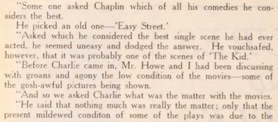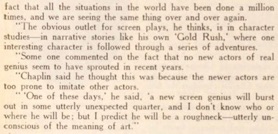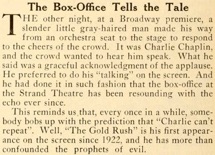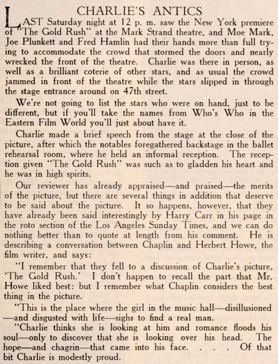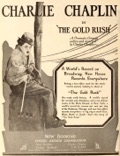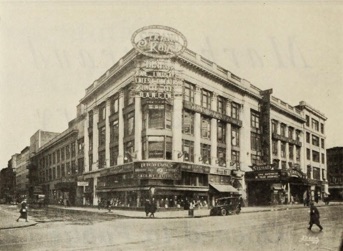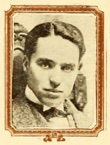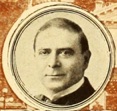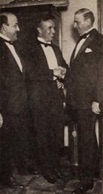The Gold Rush 1923 1924 1926 next previous
The Gold Rush Clippings 244/363
Motion Picture News, New York, August 29, 1925.
Mr. Charles Chaplin rightly believes that his
pictures are now worth more than he is receiving for them.
(...) First National Ad (twelve pages),
Moving Picture World, Feb. 22, 1919, details
& Moe Mark New York (...)
The Case for First National (...) How much are
Stars worth? What of the Independent
Producer? Where does the Exhibitor get off?
(...) First National Ad (twelve pages),
Moving Picture World, Feb. 22, 1919, details
& Joseph Plunkett, Charles Spencer Chaplin and Moe
Mark, snapped at the opening of „The Gold Rush“
(United Artists) at the Mark Strand theatre, New York.
(...) Motion Picture News, Aug. 29, 1925
& Strand, exterior by day, marquee unreadable, New York
– THE NEW YORK MARK STRAND THEATRE
Built twelve years ago, This theatre attracted world-wide
attention as it was announced that only motion
pictures would be shown in it – one picture each week.
(...) Moving Picture World, April 18, 1925
& Charlie Chaplin in „The Gold Rush“ (...)
A world‘s record for receipts and attendance, and a run
of four weeks at the Mark Strand, in New York; a world‘s
record for income per seat per day at the Orpheum, Chicago.
(...) Motion Picture News, Sept 26, 1925
& The Box-Office Tells the Tale
(...) Motion Picture News, Sept. 19, 1925
„Of that bit Charlie is modestly proud“
Editorial content. „Pictures and People
Charlie‘s Antics
Last Saturday night at 12 p. m. saw the New York
premiere of The Gold Rush at the Mark Strand theatre, and
Moe Mark, Joe Plunkett and Fred Hamlin had
their hands more than full trying to accommodate the crowd
that stormed the doors and nearly wrecked the front
of the theatre. Charlie was there in person, as well as a brilliant
coterie of other stars, and as usual the crowd jammed
in front of the theatre while the stars slipped in through the
stage entrance around the 47th street.
We‘re not going to list the stars who were on hand,
just to be different, but if you‘ll take the names from Who‘s Who
in the Eastern Film World you‘ll just about have it.
Charlie made a brief speech from the stage at the close
of the picture, after which the notables foregathered
backstage in the ballet rehearsal room, where he held an
informal reception. The reception given The Gold Rush
was such as to gladden his heart and he was in high spirits.
Our reviewer has already appraised – and praised
– the merits of the picture, but there are several things in addition
that deserve to be said about the picture. It so happens,
however, that they have already been said interestingly by
Harry Carr in his page in the roto section of the Los
Angeles Times, and we can do nothing better than to quote at
length from his comment. He is describing a conversation
between Chaplin and Herbert Howe, the film writer, and says:
,I remember that they fell to a discussion of Charlie‘s
picture, The Gold Rush. I don‘t happen to recall the part
that Mr. Howe liked best; but I remember what Chaplin considers
the best thing in the picture.
,This is the place where the girl in the music hall –
disillusioned – and disgusted with life – sighs to find a real man.
,Charlie thinks she is looking at him and romance
floods his soul – only to discover that she is looking over his
head. The hope – and chagrin – that came into his face...
Of that bit Charlie is modestly proud.
,Some one asked Chaplin which of all his comedies
he considers the best.
He picked an old one – Easy Street.
,Asked which he considered the best single scene
he had ever acted, he seemed uneasy and dodged the answer.
He vouchsafed, however, that it was probably one of the
scenes of The Kid.
,Before Charlie came in, Mr. Howe and I had been
discussing with groans and agony the low condition of the
movies – some of the gosh-awful pictures being shown.
,And so we asked Charlie what was the matter
with the movies.
,He said that nothing much was really the matter;
only that the present mildewed condition of some of the plays
was due to the fact that all the situations in the world
have been done a million times, and we are seeing the same
thing over and over again.
,The obvious outlet for screen plays, he thinks, is in
character studies – in narrative stories like his own Gold Rush,
where one interesting character is followed through
a series of adventures.
,Some one commented on the fact that no new actors
of real genius seem to have sprouted in recent years.
,Chaplin said he thought this was because the newer
actors are too prone to imitate other actors.
,One of these days,‘ he said, ,a new screen genius
will burst out in some utterly unexpected quarter, and I don‘t
know who or where he will be; but I predict he will
be a roughneck – utterly unconscious of the meaning of art.‘“
The Gold Rush opens June 26, 1925
at Grauman‘s Egyptian, 6712 Hollywood Bld., Los Angeles.
The Gold Rush opens August 15, 1925
at Strand Theatre, B‘way at 47th St., New York.
Redaktioneller Inhalt
The Gold Rush 1923 1924 1926 next previous

